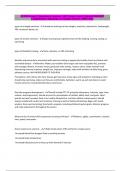ACSM Group 2 | Questions & Answers (100 %Score) Latest Updated 2024/2025
Comprehensive Questions A+ Graded Answers | 100% Pass
types of strength exercises - ✔✔resistance training via free weights, machines, plyometrics, bodyweight,
TRX, resistance bands, etc.
types of aerobic exercises - ✔✔large muscle group repetitive exercise like walking, running, cycling, or
swimming
types of flexibility training - ✔✔static, dynamic, or PNF stretching
Benefits and precautions associated with exercise training in apparently healthy clients and those with
controlled disease - ✔✔Benefits: Makes you healthier (live longer and more enjoyable life), prevents
and manages disease, increases mood, good past-time activity, reduces stress, helps maintain well
functioning immune response, weight loss, improves strength, helps with activities of daily living, gives
athletes success, WAY MORE BENEFITS THEN RISK
Precautions: with clients who have disease get clearance, know signs and symptoms indicating a client
should stop exercising, make sure they are comfortable, hydration, warm up and cool down to avoid
muscle soreness, musculoskeletal injury could occur.
Describe program development - ✔✔Should include FITT-VP principles (frequency, intensity, type, time,
volume, and progression). Should account for periodization of athlete, ability level, and goals. Sport
specific and well rounded. Goal is for healthy lifestyle first, and then athletic enhancement. Should
always include both cardio and resistance training as well as balance/stretching. Begin with needs
analysis, then exercise testing, then build a program including athletes/coaches goals. Monitor progress
and make adjustments throughout the season
What are the six motor-skill components of physical fitness? - ✔✔Balance, agility, coordination, reaction
time, speed, and power
Acute response to exercise: - ✔✔-Body breaks down CHO and fat for energy source
-Increased blood flow (oxygen flow) to working muscles
-Increased body temperature
-Increased blood pressure to keep up with demand of exercise
, -Increased heart rate
-Vasodilation to areas of the body where blood is needed
-Vasoconstriction to areas of the body that does not need a large blood supply during exercise
-Increased range of motion
-Increased breathing rate
Chronic adaptations to exercise: - ✔✔-Increased cardiovascular endurance
-Lower HR at submax effort and lower resting HR
-Increased capillary density
-Increased stroke volume
-Increased cardiac output
-Increased number of mitocondria
-Increase in blood volume
-Increased size of left ventricle of the heart and heart walls
-Increased VO2 max
-Decreased resting SBP/DBP
-Increased motor unit recruitment
-Increased hormones like testosterone and growth hormone
-Increased insulin sensitivity
FITT-VP for healthy people - ✔✔F: Greater than or equal to 5 days of moderate aerobic exercise or
greater than or equal to 3 days of vigorous aerobic exercise/ resistance training 2-3 days per week
I: Moderate-Vigorous/ 60-70% of 1RM
T: 30-60 min
T: Regular/purposeful exercise involving large muscle groups
V: A target volume of 500-1000 MET/min per week is recommended/ 2-4 sets with 8-12 reps for
resistance training
P: Continual patterns for 10 week periods/ 2-3 minute rest between sets during RT
P: Gradual progression of exercise volume by changing frequency or duration/resistance training
increase resistance




